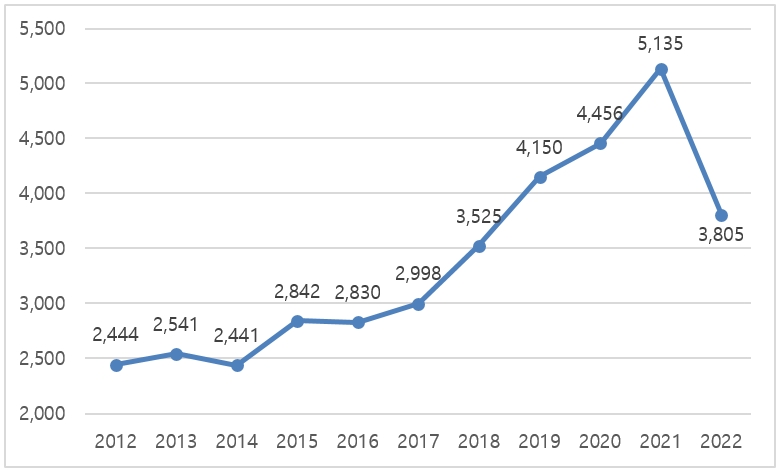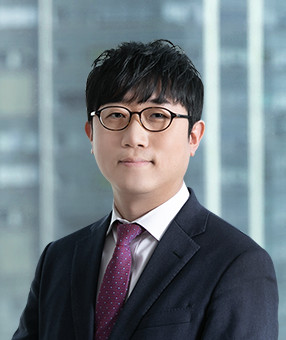On January 6, 2023, the Korean Intellectual Property Office (KIPO) published an Examination Casebook ("Casebook") regarding examination of autonomous vehicle applications. The Casebook follows publication of KIPO's patent examination guidelines ("Guidelines") in March 2022 (link), and provides valuable insight into how KIPO applies the Guidelines in practice.
Over the past five years, significant advances have been made in the autonomous vehicle technologies and the number of related patent applications filed in KIPO has increased steadily. In a press release on January 27, 2023, KIPO provided statistical information supporting this trend.

Among the applications filed at KIPO, a large portion of the applications was directed to complex technologies that combine AI (Artificial Intelligence) with sensor technology, V2X (Vehicle to Everything) and ITS (Intelligence Traffic System), and technologies that provide new services by applying autonomous vehicle technology to existing mobility systems.
The Casebook is divided into four parts corresponding to four patentability requirements under the Korean Patent Act: i) written description (Article 42(3) of the Patent Act), ii) claim scope (Article 42(4) of the Patent Act), iii) eligible subject matter (Articles 2 and 32 of the Patent Act), and iv) inventiveness (Article 29 (2) of the Patent Act). The four parts in the Casebook mirror the sections of the Guidelines and provide numerous practical examples for examiners and patent practitioners.
While the primary purpose of the Casebook is to aid KIPO examiners in examining applications related to autonomous vehicle technologies, the Casebook also provides patent practitioners with valuable insight on examination of complex technical disclosures, examination procedure of patent applications, and the like. Some examples from the Casebook are provided below.
Written Description
The Guidelines require a patent application to provide sufficient written description to allow a person of ordinary skill in the art ("POSITA") knowledgeable in autonomous vehicle technology to accurately understand and utilize the invention without any additional prior knowledge. To this end, KIPO considers the state of the relevant technology (e.g., SAE autonomous driving level) at the time of filing a patent application. The Casebook introduces several cases providing guidance on the state of the relevant technology.
Case 1
- Written description was not met as the SAE autonomous driving level existing at the time of filing the application was Level 2, but the disclosure in the application required a minimum of Level 4. The application disclosed a system in which a parked autonomous vehicle is temporarily driven without any driver intervention by recognizing a voice command of someone other than the driver (such as in a congested parking lot where vehicles are blocking each other). The specification discloses a technology for performing autonomous driving that is at least Level 4 or higher, but does not provide any specific means for achieving the disclosed technology.
Case 2
- Written description was not met as the specification does not provide sufficient disclosure regarding how an autonomous vehicle's internal monitoring system could recognize whether an occupant is in a meeting. The application disclosed a system where the autonomous vehicle's internal monitoring system recognizes occupants' behavior such as sleeping, reading, drinking, operating a mobile phone, watching a movie, participating in a meeting. While the examiner agreed that a POSITA would understand how the internal monitoring system would recognize most of the occupant behavior mentioned above, the specification does not provide sufficient disclosure regarding how the internal monitoring system determines whether an occupant is in a meeting as it would have to use advanced algorithms to specifically recognize such a behavior that would not have been known at the time to a POSITA.
Eligible Subject Matter
With respect to eligible subject matter, the Guidelines provide that an autonomous vehicle related invention cannot be patented if its implementation results in a violation of regulations related to public interest, such as traffic laws. However, an exception is made if the violation was for a reasonable purpose when considered together with the invention's disclosure.
Case 1
- An invention that controls a vehicle to stop in a no-parking zone for the convenience of its occupants is not patentable. However, when read with the invention's description which discloses a vehicle that stops in a no-parking zone to prevent collisions and accidents with other vehicles based on reasonable judgement, the invention is patentable.
Inventiveness
Since autonomous vehicle inventions relate to application and convergence of different technologies such as sensors, information and communication, and computer technologies for existing automobile technologies, even if the cited invention is not classified as an autonomous vehicle technology, an invention may be rejected for lack of inventiveness by combining cited inventions related to non-autonomous vehicle technology with related autonomous driving references.
Case 1
- A cited invention directed to a ground laser scanner that performs intensity correction on the laser scanner to improve the accuracy of distance measurements for buildings and terrain may be cited as prior art reference for an invention directed to improving the reliability of road surface detection results by performing intensity correction in an autonomous vehicle.
Publication of the Casebook is expected to lead to a more consistent examination of autonomous vehicle applications at KIPO while providing applicants more predictability on examination of their applications at KIPO.
Related Topics






